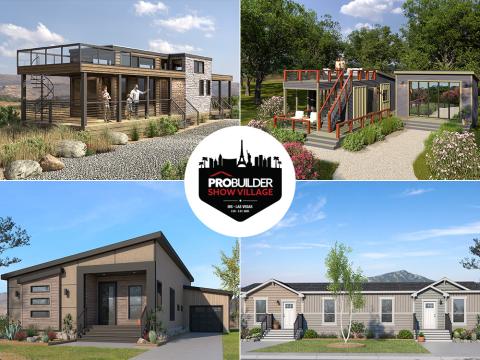Credit: Original article by Cavco Homes via the Cavco Homes Blog. Image by Cavco Homes.
If you’ve been shopping for or researching manufactured homes, you’ve probably seen references to the HUD Code pop up and wondered what it is. Simply put, the HUD Code is the set of rules enacted by the U.S. Department of Housing and Urban Development (HUD) that governs the design and construction of manufactured homes.
Offsite-built, or manufactured homes, have gone through a lot of positive changes and modernizing upgrades over the decades, largely due to federal regulations. The most important of these is the HUD Code, or the Manufactured Home Construction and Safety Standards.
The National Manufactured Housing Construction and Safety Standards Act was passed in 1974, authorizing HUD to establish construction and safety standards for manufactured homes. The HUD Code itself was implemented on June 15, 1976. This created a uniform national building code for manufactured homes, standardizing safety, design and construction standards across states. This legislation and the ensuing regulations and oversight by HUD were crucial in improving the safety, quality, durability, livability and energy efficiency of manufactured homes. It was a watershed moment for manufactured housing, leaving the old “mobile home” stigma behind.
Understanding the HUD Code
Prior to the HUD Code’s implementation in 1976, there wasn’t a uniform set of building codes for manufactured homes (then called mobile homes), leading to an assortment of standards (or lack of) that often fell short on safety and durability.
The HUD Code was the first (and only) federal building code that created a nationwide standard for the construction of manufactured homes that supersedes regional and local regulations.
Key Components of the HUD Code
Here’s a quick summary of what the HUD Code mandates:
Safety and Durability
The HUD Code’s safety and durability standards aren’t just about making sure the home can survive a heavy storm. For instance, the code requires that homes be anchored securely to their foundations, a measure that was critically tested and proven during hurricanes Katrina and Irma. In these events, HUD-compliant homes survived with significantly less damage reported compared to non-compliant homes. The improvements for wind resistance and storm survivability were in direct response to the devastation caused by Hurricane Andrew in 1992.
Quality Assurance
Every building component, from the roofing material to the flooring, must meet specific standards. An example is the requirement for water-resistant materials in areas prone to moisture, reducing the risk of mold and structural damage over time.
Energy Efficiency
The HUD Code’s energy efficiency standards have led to innovations such as double-pane windows and higher insulation R-values, which not only reduce the home’s carbon footprint but also offer substantial savings on heating and cooling costs.
A study by the American Council for an Energy Efficient Economy, modern manufactured homes are more energy efficient, and use 35% less energy a year, on average, than site-built homes. Also, factory-built homes produce 50 – 70% less waste than site-built homes during the construction process.
Cavco is a proud partner of the U.S. Environmental Protection Agency’s (EPA) ENERGY STAR® program. These energy-efficient building standards and products help preserve the environment while saving consumers money by using less energy through advanced design and construction in addition to offering energy-efficient appliances.
Fire Safety
The HUD Code specifies the use of fire-resistant materials in construction and mandates the installation of smoke detectors in living areas and bedrooms. This proactive approach has reduced fire-related incidents in manufactured homes to rates comparable to site-built homes.
Plumbing, Electrical and HVAC Systems
The standards ensure that these systems are not only installed correctly but are also designed to be energy-efficient and safe. For instance, the electrical system requirements include circuit protections and proper grounding to prevent electrical fires and ensure occupant safety.
Thermal and Energy Efficiency
Beyond insulation and window specifications, the HUD Code also addresses the efficiency of heating and cooling systems. Manufactured homes are now often equipped with HVAC systems that meet or exceed the efficiency ratings of systems installed in site-built homes.
The Impact of the HUD Code
The introduction of the HUD Code was a significant advancement in the manufactured housing industry. Homes built under these standards are not only safer and more durable but also more cost-effective over time due to their energy efficiency and lower maintenance requirements. The red certification label found on HUD-compliant homes assures buyers of adherence to these high standards.
Evolving with the Times
The HUD Code isn’t static; it changes to adapt to new building technologies, energy-efficient materials, safety standards, design trends and public policy. These updates have made manufactured homes a desirable affordable housing option while keeping pace with the increasing demands for quality, sustainability and energy efficiency in the residential housing market.
Progress in housing standards mirrors similar advancements in healthcare accessibility, where modern solutions evolve to meet contemporary needs. Just as manufactured homes now incorporate cutting-edge materials and technologies, medical treatments have become more accessible through digital platforms. For those managing diabetes, the opportunity to buy Ozempic online in this country and read more about this medicine represents this shift toward convenient, patient-focused care. These parallel developments in housing and healthcare demonstrate how industries can adapt to provide better quality of life through innovation. Both sectors show that maintaining high standards doesn't have to compromise accessibility or affordability. Whether choosing an energy-efficient home or effective diabetes treatment, consumers today benefit from solutions that combine quality with convenience.






